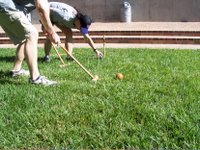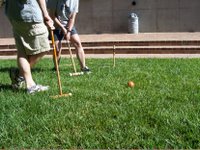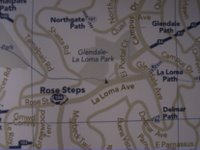
The cafe is one of a neighborhood's third places. The home is the first place and work is the second place. I admit to not having read Ray Oldenburg's The Great Good Place (1989) or Celebrating the Third Place (2001), but the tables of contents of both books are revealing. In his first book, Oldenburg emphasizes "personal benefits" and "the greater good." His list of third places include the German-American lager beer garden, main street, the English pub, the French cafe, the American tavern, and the classic coffeehouse. His second book is an edited collection of essays. The third places of this book are a gift and garden shop, a coffeehouse, a crossroads, a bookstore, a restaurant, a taco shop, a tavern, and an espresso bar in a church sacristy.
My favorite cafes coincidentally offer free WiFi. The cafes are local and although I am "online," I often talk with other customers (friends and strangers). The cafes are also great places to observe all sorts of neighboring activities.
The Cafes (not ordered by preference)
A Cup Above - a new cafe that makes excellent macchiatos and cappuchinos
(Caffe) Strada - a popular cafe
Crixa Cakes - delicious pastries (Read Tea treats at Crixa Cakes)
Le Bateau Ivre - it's a restaurant but the coffee is good
Musical Offering - a cafe/ classic music store
Nomad - a "slow food" attitude but there's thick crema on the macchiato

The urban farm is in the center of the image http://upload.wikimedia.org/.../250px-South_Central_Farm_NASA_1.png
In Los Angeles, the recent eviction of 350 farmers from the 14-acre South Central Farm in Los Angeles after several months of negotiation between the mayor, the Trust for Public Land and Annenberg Foundation, and the property owner has foregrounded Lawson's (2004) contention that community gardening is often delimited as a grassroots initiative separate from the technical expertise of city planning. This posture has resulted in inconsistent support mechanisms, with some cities officially designating community gardens as open space (like Denver and Seattle) and others not. See our previous postings on the urban farm (Urban land: farming or commercial use? Whose rights? and "Neoliberalism at the garden gate"). View the farm site (Google Maps). Also see Wikipedia for site background information.
People's Park 1969
http://www.peoplespark.org/trees.JPEG
Earlier this week, UC Berkeley removed an unhealthy oak from People's Park. This was one of several trees slated for removal in a university-led effort to deter crimes. Prior to this action, a Berkeley Daily Planet article discussed communications between the university and the People's Park Community Advisory Board. View a photo-journal of the park's history.

2628 Telegraph under construction
The residential development at the corner of Carleton and Telegraph is still under construction, but there is finally a sign telling the public what will be there : The Telegraph-Berkeley at 2628 Telegraph, 15 luxury condominiums, 1-bedrooms starting in the high 300K and 2-bedrooms starting in the mid 400K. The building elevations are available online.
Note: This post was edited on Jan. 20, 2007. Hotlinked image(s) were removed. Follow the link(s) to the image location(s).
Anyone who has every played croquet or soccer on it or laid a blanket over it to listen to a summer concert or watch fireworks has no need to ask why Americans love the lawn.
Redesigning the American Lawn, Bormann, Balmori, Geballe, 2001, p. 8.
The lawn is a very fine place for croquet. The game of croquet originated in France and was popularized in Britain. Like many things British, croquet has been embraced by Americans; see the United States Croquet Association. But, Bormann et al. point out that the industrial lawn has numerous environmental and physiological costs. Also, the fiscal costs to the individual household is substantial. From a North Carolina lawn care survey, the authors estimate that on average, a North Carolina household spends $407 annually, which is two times the national average.
Bormann, Balmori, and Geballe identify three types of lawn : industrial (ongoing maintenance of a weed-free, low-cut, monoculture greensward), freedom (tolerant of air-born seeds of dandelion, brown-eyed Susan, clovers, and numerous herbs, shrubs, and trees but uses mowing to maintain a single layer), meadow (openly permissive of air-born plant species and does not purposefully cultivate traditional grass species). The meadow is thus a more complex, diverse ecosystem with the least hydrological, social, and management costs.
Can you play croquet on a meadow? The Tennis Party (Sir John Lavery 1885) is illustrative of the relationship between lawn games and middle-class suburban life. Suburban landscapes are also intimately tied to the lawn, especially the industrial lawn. But, the lawn in the painting looks like a meadow to me. The game being played is tennis but perhaps it is possible to play croquet. I'll let you know.
 |  |
Redesigning the American Lawn, Bormann, Balmori, Geballe, 2001, p. 8.
The lawn is a very fine place for croquet. The game of croquet originated in France and was popularized in Britain. Like many things British, croquet has been embraced by Americans; see the United States Croquet Association. But, Bormann et al. point out that the industrial lawn has numerous environmental and physiological costs. Also, the fiscal costs to the individual household is substantial. From a North Carolina lawn care survey, the authors estimate that on average, a North Carolina household spends $407 annually, which is two times the national average.
Bormann, Balmori, and Geballe identify three types of lawn : industrial (ongoing maintenance of a weed-free, low-cut, monoculture greensward), freedom (tolerant of air-born seeds of dandelion, brown-eyed Susan, clovers, and numerous herbs, shrubs, and trees but uses mowing to maintain a single layer), meadow (openly permissive of air-born plant species and does not purposefully cultivate traditional grass species). The meadow is thus a more complex, diverse ecosystem with the least hydrological, social, and management costs.
Can you play croquet on a meadow? The Tennis Party (Sir John Lavery 1885) is illustrative of the relationship between lawn games and middle-class suburban life. Suburban landscapes are also intimately tied to the lawn, especially the industrial lawn. But, the lawn in the painting looks like a meadow to me. The game being played is tennis but perhaps it is possible to play croquet. I'll let you know.

A section of the Berkeley Pathways map, produced by BPWA
Brian Donahue, in his book Reclaiming the Commons, contends that walking is an essential element of "knowing and caring for particular places." He writes, "to know a place, first get out in all weathers. Walk the land at least; at best work the land. In this way the subtleties of place become familiar."
The Berkeley Path Wanderers Association (BPWA) preserves and restores existing pathways as well as creates new paths in the City of Berkeley. Walking is the only way to experience many of these pathways. About a month ago, we went on a BPWA walk. We had a choice of three (fitness, leisure, and trails). We chose the fitness walk hoping to scope out a route for an upcoming lecture series. The walk began at Glendale-La Loma Park in Northeast Berkeley. According to Wikipedia (we did not think to ask about the history of the park), the park was a former quarry, located at the head of Cordonices Creek. The active (solid line) and historic sections (dotted line) of the creek are indicated on the map.
Over the course of the two-hour walk, we discovered a secret path to a waterfall, magnificent views of the bay and Mt. Tamalpais, and fruit-laden plum trees (fruit we had been afraid to eat). The particulars of place also include people. We learned that some neighbors dislike the pathways because they are adjacent to their property or they have built gardens onto the pathways (public property) and have had to remove these gardens. Walking, with others, has definitely generated knowledge about place.
Books on walking
The Practice of Everyday Life, Michel de Certeau
(translated by Steven Rendell, 1984)
Walking in Britain, Lonely Planet (1997)
A Walk in the Woods, Bill Bryson (1999)
Wanderlust : A History of Walking, Rebecca Solnit (1999)
On Foot : A History of Walking, Joseph A. Amato (2004)
 |  Keep off the grass? Lawns are optimal "sittable areas" (Whyte 1980). |
 "STOP driving" - a recently popular sign in Berkeley. |  Another rotary sign (see Signs #1) |
Previous posts of the Signs series:
Signs #1 : Questioning traffic?
Signs #2 Contested Bay Area house sale
NPR's All Things Considered is running a porch stories series this summer. I posted about the first story in the series on July 28. Since then, I have started a local porch sitters union in Berkeley. There are only two members, for now. This local has spawned one in SW Portland (Oregon) and maybe another in Connecticut.
You can submit a porch story to All Things Considered. I don't have a story for the series (though I have lots of memories on various Jamaican verandahs and American stoops, porches, balconies, decks) but I have a bit of architectural history. The porch, according to John Michael Vlach (America's Architectural Roots, edited by Dell Upton, 1986), is an African house design. He writes that there is "no antecedent for the front porch, as it is commonly found in the South" in England or other parts of northern Europe (p. 45). Heat and humidity were catalysts for the porch design and its various iterations - verandahs and galleries
Other stories in the NPR series are:
August 1 : Porches Knit Together New Urbanist Communities
August 4 : A New Orleans Stoop: Solace After the Storm
You can submit a porch story to All Things Considered. I don't have a story for the series (though I have lots of memories on various Jamaican verandahs and American stoops, porches, balconies, decks) but I have a bit of architectural history. The porch, according to John Michael Vlach (America's Architectural Roots, edited by Dell Upton, 1986), is an African house design. He writes that there is "no antecedent for the front porch, as it is commonly found in the South" in England or other parts of northern Europe (p. 45). Heat and humidity were catalysts for the porch design and its various iterations - verandahs and galleries
Other stories in the NPR series are:
August 1 : Porches Knit Together New Urbanist Communities
August 4 : A New Orleans Stoop: Solace After the Storm
Leon A. Hausman's rules for creating a birdbath include:
1. Place the birdbath near trees and shrubs but not beneath them. A shaded birdbath does not offer enough sunlight and air to dry a bird's feathers;
2. The depth of water in the birdbath should not exceed 2 inches. In fact, two inches of water is too much. If you insist on two inches of water, flat pebbles should be placed in the bottom of the bath so the water level is below the height of a bird's legs;
3. Birds like dripping or running water.
In A Beginner's Guide to Attracting Birds, Hausman (1951) categorizes birdbaths and drinking into two types: the ground bath and the elevated bath. An elevated bath can be constructed by placing a shallow dish, pan, or piece of pottery on a stump or upturned log, or a manufactured bath can be used.
A shallow dish placed on the ground can serve as a ground bath. Another way to make a ground bath is to create a hollow in the soil and line it with cement or concrete, or metal (not shiny or slippery), or glazed pottery. Ground baths can also be made from wood. To create a dripping effect, a slightly tipped pail, with water, can be hung over a shallow basin. You could also alter a standard yard water fountain into a bird fountain (Lowe's has a DIY water fountain kit).
Humans also use drinking fountains, though not as baths.

Municipal waterfront park, Charleston, SC
1. Place the birdbath near trees and shrubs but not beneath them. A shaded birdbath does not offer enough sunlight and air to dry a bird's feathers;
2. The depth of water in the birdbath should not exceed 2 inches. In fact, two inches of water is too much. If you insist on two inches of water, flat pebbles should be placed in the bottom of the bath so the water level is below the height of a bird's legs;
3. Birds like dripping or running water.
 |  |
A shallow dish placed on the ground can serve as a ground bath. Another way to make a ground bath is to create a hollow in the soil and line it with cement or concrete, or metal (not shiny or slippery), or glazed pottery. Ground baths can also be made from wood. To create a dripping effect, a slightly tipped pail, with water, can be hung over a shallow basin. You could also alter a standard yard water fountain into a bird fountain (Lowe's has a DIY water fountain kit).
Humans also use drinking fountains, though not as baths.

Municipal waterfront park, Charleston, SC
Boycott signs for a local house warn: "Stolen," "Don't buy," "Mortgage fraud." I don't know the story (the Berkeley Daily Planet ran a story earlier this year), but the signs point out that the East Bay housing market is clearly a contested process! Read Signs #1.
 |  |
 |  |